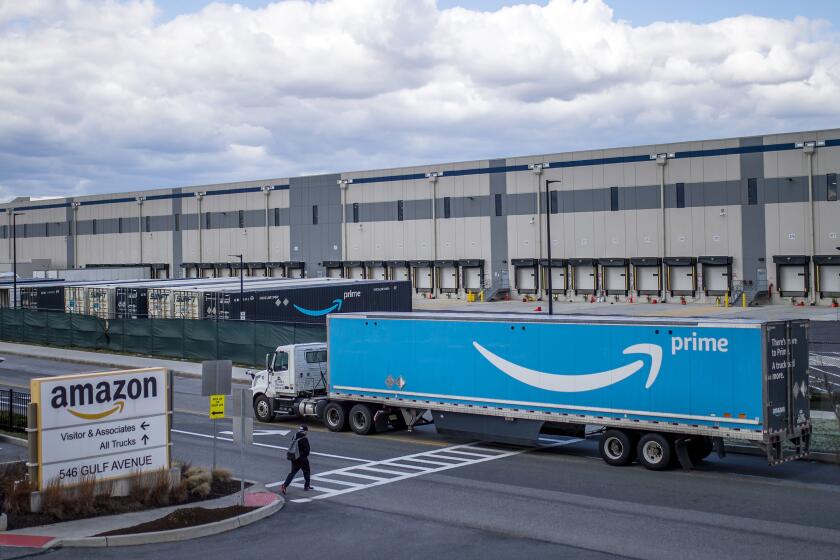Wholesale Prices Up Just 0.4%, Easing Concerns
- Share via
Easing fears that an overheated U.S. economy could kindle higher inflation and interest rates, the government said Friday that prices at the wholesale level rose an unexpectedly low 0.4% last month.
Stock and bond prices rallied on the Labor Department report as investors cheered the prospect of continued mild inflation that would keep a lid on lending costs.
The Dow Jones average of 30 industrial stocks jumped 43 points to 5,518.14, and the price of the benchmark 30-year Treasury bond climbed more than $9 for every $1,000 in face value. That pushed the bond’s yield down to 6.92% from 7.01% late Thursday.
Robust growth in the economy, together with well-publicized increases in the prices of gasoline and certain foods, had raised concern that the April report on wholesale prices would show a sharp increase.
Such a scenario, in turn, had worried financial markets that the Federal Reserve Board--in an effort to slow the economy and keep inflation in check--would raise interest rates within the next several weeks. The board’s policymaking committee next meets on May 21.
Instead, the report released Friday “is unambiguously positive for the outlook on inflation,” said Mickey D. Levy, chief financial economist at NationsBanc Capital Markets Inc. in New York. “The Fed should be very happy with the way things look.”
That sentiment was echoed by Clinton administration officials. Treasury Secretary Robert Rubin, after a meeting with business leaders in Williamsburg, Va., told reporters that “the outlook for inflation remains very favorable.”
To be sure, inflation at the wholesale level--as measured by the Labor Department’s producer price index--is running at a rate of about 3% this year, ahead of the 1.9% rate set in 1995. The PPI measures the cost of goods and services before they reach the consumer.
But this year’s pace is not a cause for alarm, and even the latest surge in gasoline prices did not lift overall wholesale inflation to worrisome levels, economists said. Gasoline costs jumped 6.1% after climbing 7.1% the previous month, a stark reversal from last year when they generally fell.
Yet economists generally discounted the latest increases, calling them temporary and unlikely to swell the overall inflation rate noticeably.
Indeed, because prices of fuel and food tend to take wide monthly swings--and are often beyond the Fed’s ability to influence--economists typically exclude food and energy to measure the “core” wholesale inflation rate. And that gauge for April showed an even smaller increase of 0.1%.
Consumers certainly notice changes in energy and food costs, but those price swings “don’t tend to be lasting, and therefore you don’t want [the Fed] to respond to something that’s transitory and out of its control,” said John R. Williams, chief markets economist at Bankers Trust New York Corp.
Nonetheless, analysts said it remains to be seen how much the surge in gasoline prices will affect prices at the consumer level. The Labor Department will release its consumer price index for April on Tuesday.
Economists also said this year’s drought in the Plains States is not likely to have a major effect on food prices, at least not this year. In a separate report released Friday, the Department of Agriculture estimated that the drought conditions would reduce the winter wheat harvest by 12% this year to 1.4 billion bushels, its lowest level since 1978.
Last month, overall wholesale food costs fell 0.3% after rising 0.6% in March, a turnaround that was partly credited to a volatile swing in vegetable prices, which plunged 15.5% last month after soaring 43% in March.
Despite the favorable price report for April, some economists said a higher rate of inflation lurks on the horizon.
“We remain concerned that the economy is ready to overheat,” Williams said. The problem is not energy or food, but the cost of labor, he said.
“Labor is about 70% of the cost of producing goods and services, and all of the evidence suggests that the labor market is quite tight,” meaning that because the economy and employment growth are both strong, workers will seek significant wage gains.
Employers naturally would factor those pay increases into the prices they charge for their goods and services, and that could send general inflation sharply higher, he said.
But Levy of NationsBanc Capital Markets disagreed. He said that even as wages are going up, worker productivity is going up in tandem, and, therefore, the wage-related inflation threat is neutralized.
Times wire services contributed to this report.
More to Read
Inside the business of entertainment
The Wide Shot brings you news, analysis and insights on everything from streaming wars to production — and what it all means for the future.
You may occasionally receive promotional content from the Los Angeles Times.











